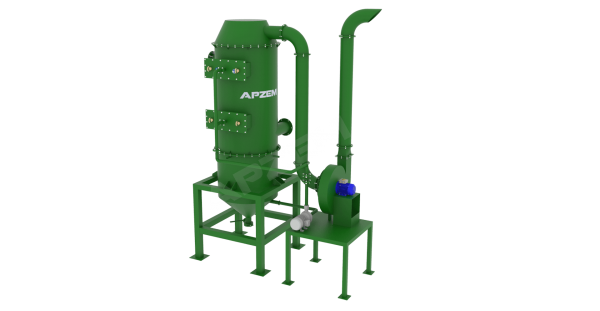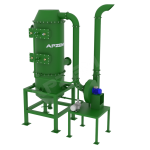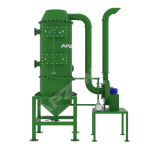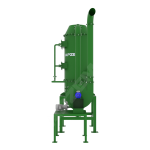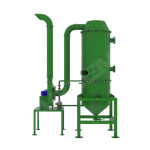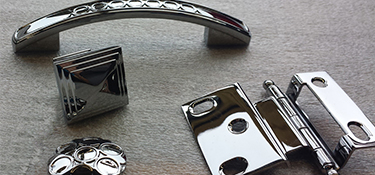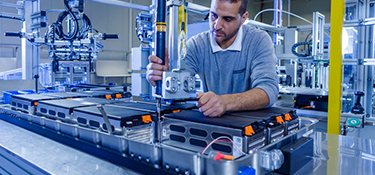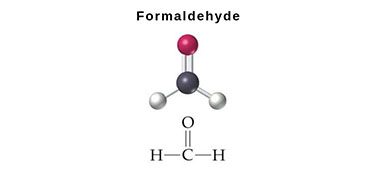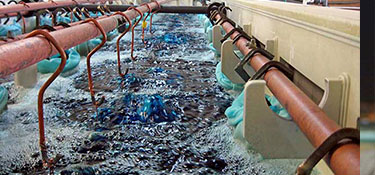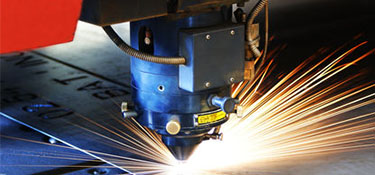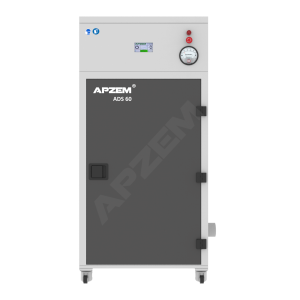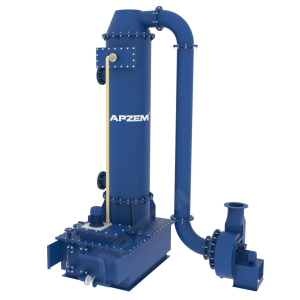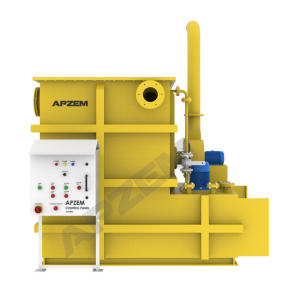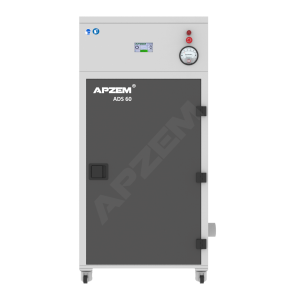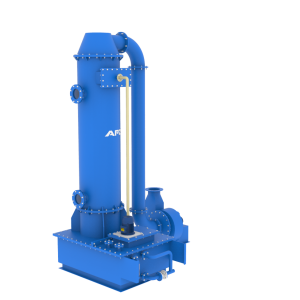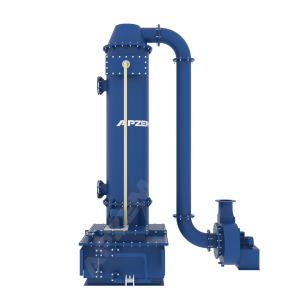Product Details
SPRAY TOWER
spray tower scrubber
An open cylindrical tower consist of spray nozzles to create number spray zones in which the contaminated gas is passed. Pollutants from the gas dissolve in the liquid based on the absorption technology. Spray nozzles are arranged in such a way that spray zones should cover cross sectional area of tower. There is no packing material / tray arranged in the tower to enhance contact between liquid and gas. Mainly, the spray tower is used in applications the requirement is low pressure drop and moderate separation efficiency.
Description
SPRAY TOWER
spray tower scrubber
An open cylindrical tower consist of spray nozzles to create number spray zones in which the contaminated gas is passed. Pollutants from the gas dissolve in the liquid based on the absorption technology. Spray nozzles are arranged in such a way that spray zones should cover cross sectional area of tower. There is no packing material / tray arranged in the tower to enhance contact between liquid and gas. Mainly, the spray tower is used in applications the requirement is low pressure drop and moderate separation efficiency.
The pressure drop across the tower is very low, less than 1 inch water column.
Here, spray nozzles disperse the liquid into fine droplets to offer contact area for gas and liquid without arranging packing materials or column internals. The pressure drop is much lower in spray tower than packed bed column because of no arrangement of packing materials.
Spray tower can be used for pollutants which form scaling in the tower. Particles in the gas stream will form blockage in the packing materials or holes in tray column. This reduces the passage of liquid and gas and increase the pressure drop in packed bed or trays. On the other hand, there is no need of packing materials or trays, there will be no issue of plugging.
However, plugging of spray nozzles is possible if the solvent contains concentrated pollutants/slurries. To avoid the spray nozzles plugging, nozzles are designed with large open area.
Spray tower is mainly used for flue gas desulfurization
In power plants, the use of sulphur in the coal causes formation of sulphur di oxide (SO2), which is highly hazardous to human health and surroundings. This emission can be controlled by using of spray tower.
Limestone will be using as scrubbing liquid for neutralizing sulphur di oxide. The flue gas containing SO2 enter at bottom of the tower and simultaneously limestone slurry is sprayed at counter current direction. The spray nozzles are arranged to obtain good coverage of cross sectional area of tower to ensure gases should get wet by liquid droplets without bypassing.
SO2 is absorbed into the liquid and reacts with limestone in the liquid. After the reaction, the cleaned gas is passed through mist eliminator to drain water droplets before exhausting into the atmosphere. Mist eliminator helps to avoid water loss and minimize water consumption. Meanwhile, the used limestone water falls back into the tank, which is located under the spray tower, and will be recirculated by using of water pump. As the process goes, the limestone will be consumed by pollutants, there will be need of addition of limestone into the tank.
Factors affect the scrubber performance
Improper design of spray tower cause poor performance and less efficiency even if we have proper operation and good checklists. The followings are included in the scrubber performance.
Selection of solvent
The most important thing in scrubber is solvent selection. Improper selection of solvent can reduce the scrubber efficiency. Therefore it required to take care of solvent used in the spray tower.
Solvent will be used based on the pollutants in the exhaust gases.
For example, Acids: NaOH, Limestone,lAlkali, Ammonia: H2SO4
The concentration to be maintained in the scrubbing liquid is another important thing to achieve optimum efficiency. For any clarifications, regarding concentration in scrubbing liquid, please contact us: sales@apzem.com
Solvent replacement
It is required to keep concentration gradient between gas and liquid phase. If the concentration gradient is not maintained, the efficiency will drop quickly. Suppose, if the exhaust gas has lesser pollutant concentration than measured, there will be action of stripping from liquid into gas, in case of loss of gradient. This causes outlet emission problem.
So, it is required to replace the water if it reaches particular concentration level. For continuous scrubber operation, the scrubbing liquid is added while the used solvent is blow down simultaneously without affecting scrubbing process. Also, make up water will be added to compensate the water loss due to evaporation in the scrubbing column because of high temperature of exhaust gas.
Sizing of vessel
Vessel is sized by considering flow velocity through the column to optimize.
Spray pattern
- Spray nozzles create a variety of patterns, including, full cone spray, flat spray and hollow cone spray pattern.
- Full cone spray is conical spray with circular cross sectional area.
- The flat spray is thin, triangular spray and has elliptical or rectangular cross section.
- Hollow cone spray is conical spray with ring shaped cross section. It generates smaller droplets than full cone spray. Hence, Hollow cone sprays are favoured for heat and mass transfer since the smaller droplets have higher surface area.
Sizing of pump and blower
The pump and blower capacity is determined by calculating pressure drop across the column and pipes.
pH/Conductivity in scrubbing liquid
The pH in the scrubbing liquid is continuously monitored and adjusted to maintain the constant removal efficiency. If the pH level in the Scrubbing tank decreases the efficiency of scrubber will be decreased drastically. Maintaining the pH manually will be a problem for continuous production conditions. In order to avoid that, the Dosing System along with pH monitor will be fitted. The pH monitor will continuously monitor the pH level. If the pH falls below or raises it will automatically raises the audio visual alarm. And also operates the dosing pump through the relay output accordingly thus maintaining the pH level.
Note: pH is considered if the concentration of scrubbing liquid is less than 4 %. If the scrubber uses strong caustic (10 – 15 %), the pH is not recommended because direct exposure of pH probe/electrode to high concentrated caustic will damage the pH probe, thus leads to fluctuation/failure in pH monitoring.
Conductivity is non-specific for particular chemicals. Conductivity meter will respond for both reactant and product in scrubbing liquid. If the scrubbing chemical decrease, there will be decrease in the conductivity. The scrubbing liquid can be discharged and directed to ETP, if there is significance drops in conductivity
Features of spray tower scrubber
- Low pressure drop
- Lesser energy consumption
- No formation of scaling or blockage in the tower
- Suitable for both gaseous and particulates
- Can handle gas with fluctuating flow rate
- Easy installation
- Easy operation and maintenance
- Mass transfer may not be enough to achieve high efficiency
- Moderate efficiency
- May lead to blockage in the spray nozzles
https://www.apzem.in/index.php/product/spray-tower-scrubber/

